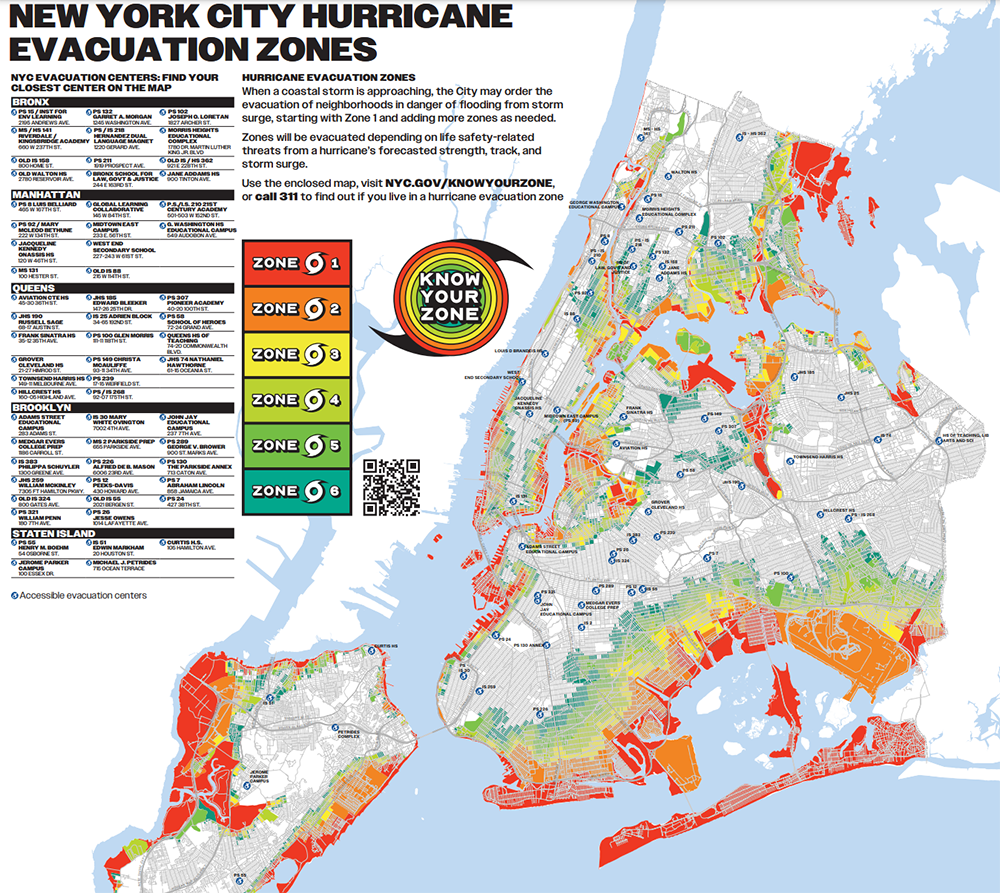
 Emergency Management311
Emergency Management311 Search all NYC.gov websites
Search all NYC.gov websites
COASTAL STORMS & HURRICANES: KNOW YOUR ZONE!
If a coastal storm or hurricane hits NYC, would you know what to do?
If a big storm hits, The City may order residents in certain zones to evacuate depending on the hurricane's track and projected storm surge. Knowing your hurricane evacuation zone in advance can prevent stress and evacuation delays if you are asked to evacuate because of an incoming hurricane or coastal storm.
Visit maps.nyc.gov/hurricane to see if you’re in an evacuation zone
Maps.nyc.gov/hurricane will let you know if you’re located in a zone and will show you your nearest evacuation center. You can also call 311 (212-639-9675 for Video Relay Service, or TTY: 212-504-4115) to find out if you live in a zone.
Maps.nyc.gov/hurricane also shows City evacuation centers which are all pet friendly.
If you live in an evacuation zone, have a plan for where you will go if an evacuation order is issued for your area. If you are not in a zone, make a plan to lose power.
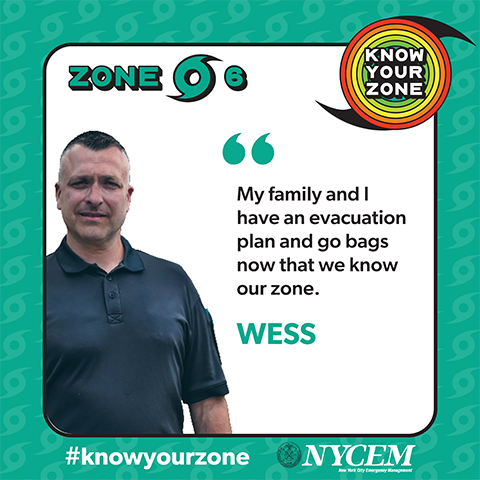
Knowing your hurricane evacuation zone in advance can prevent stress and evacuation delays if you are asked to evacuate because of an incoming hurricane or coastal storm.
Visit maps.nyc.gov/hurricane or call 311 (212-639-9675 for Video Relay Service, or TTY: 212-504-4115) to find out if your address is in an evacuation zone.
Note: FEMA Flood zones are used to determine flood insurance requirements and building code. Residents should not use FEMA’s flood zones to determine the need to evacuate during coastal storms. The City will determine which of the hurricane evacuation zones (from zone 1 up through zone 6) should be evacuated based on the characteristics of an actual storm as it is approaching the city. For more information about flood zones, visit www.floodhelpny.org.
Click a topic, or press the enter key on a topic, to reveal its answer.
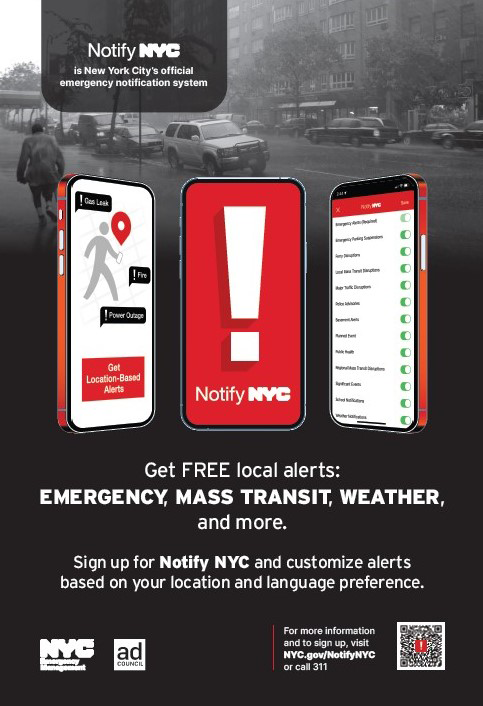
Notify NYC is the City’s official emergency notification system. Receive free customizable alerts in 13 different languages for emergencies impacting your neighborhood including hurricanes, local mass transit disruptions, traffic delays, and more!
Sign up at following us on Twitter at @NotifyNYC (available in 13 languages including @NNYCSpanish and @NNYCChinese) or calling 311 (212-639-9675 for Video Relay Service, or TTY: 212-504-4115).
KNOW YOUR ZONE! Check if your closest evacuation center is open using the Hurricane Evacuation Zone Finder before you leave. Here is an overview of the hurricane evacuation zones. Please use the visit maps.nyc.gov/hurricane to get your zone in more detail.
- If you live in a basement or below grade apartment, you may be vulnerable to flooding even if you are not located in a hurricane evacuation zone. Follow City guidance for additional actions that may be directed toward below grade dwellings.
- Zones are color-coded and labeled 1, 2, 3, 4, 5, and 6 when represented on a map. If your address is in one of the City’s hurricane evacuation zones, you may be ordered to evacuate if a hurricane threatens New York City.
Develop a plan with your household members that outlines what to do, how to find each other, and how to communicate if a hurricane hits the city.
- Use the Ready New York: My Emergency Plan Hurricane Guide at nyc.gov/readyny.
- Have the right insurance. Flood and wind damage are not covered by basic policies in renters and homeowners insurance. You will need to buy a separate policy to protect your home or business in case of flooding. All homeowners, renters, and business owners are eligible for flood insurance. Floodhelpny.org and www.floodsmart.gov have more information about how to find the right flood insurance for you.
- Gather supplies. Every household member should have a Go Bag — a collection of items you may need during an evacuation — packed in an easy-to-carry container such as a backpack. Purchase emergency supplies like bottled water and food that doesn’t need to be refrigerated, as well as basic medical supplies.
- Make sure you have flashlights and extra batteries.
- Charge cell phone batteries. If you have a portable charger, charge that as well.
- Fill your bathtub and other large containers with water — you may lose water service if the power goes out.
- Refill prescription medications ahead of the storm.
- Bring inside loose, lightweight objects, such as lawn furniture and garbage cans.
- Move valuable items from basements to upper floors. (Basements are vulnerable to flooding.)
- Anchor objects that will be unsafe to bring inside, like gas grills or propane tanks. Turn off propane tanks.
- Close windows and outside doors securely.
- Top off your vehicle and generator with fuel.
- Consider moving your vehicle to higher ground if you live in an evacuation zone.
- Turn your refrigerator and freezer to a colder setting. If you lose power, items that need refrigeration will stay cooler for longer.
- Take out extra cash, including small bills if possible.
- Take photos of valuable belongings in case they are needed for insurance purposes or disaster assistance after the storm.
- Residents of high-rise apartment buildings and basement apartments may face special risks from hurricanes even if they live outside evacuation zone boundaries.
- If you live in a high-rise building, make sure your windows are closed, stay away from windows in case they break or shatter.
- Basements are vulnerable to flooding. If you live in a basement apartment, be prepared to take shelter above ground.
Keep enough supplies in your home for up to seven days. You may need to shelter in place (stay at home) during and after a hurricane. Additionally, basic services, such as electricity, water, public transportation, and telephones may be disrupted for several days or longer. Make sure that you have enough additional supplies for potential service outages.
More Resources
Coastal storm-related health and safety tips from the NYC Department of Health & Mental Hygiene.

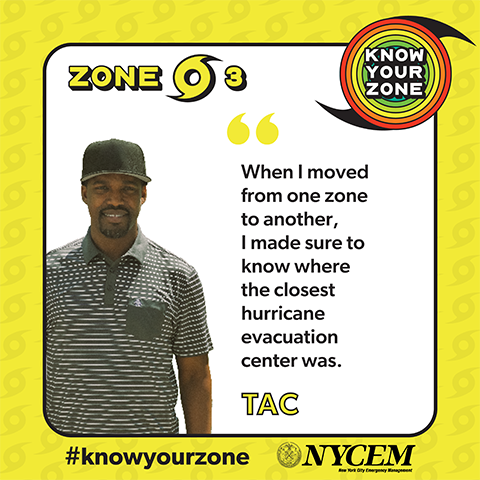
When a coastal storm is approaching, the City may order the evacuation of neighborhoods in danger of flooding from storm surge, starting with zone 1 and adding more zones as needed. Zones will be evacuated depending on life safety-related threats from a hurricane’s forecasted strength, track, and storm surge.
- Pay attention to local guidance about updated plans for evacuation and evacuation centers.
- Make plans to stay with friends or family outside of an evacuation zone.
- If you cannot stay with friends or family, you can stay in a city evacuation center.
- Use the Hurricane Evacuation Zone Finder, or call 311 (212-639-9675 for Video Relay Service, or TTY: 212-504-4115) to identify which evacuation center is most appropriate for you.
Evacuation information is subject to change. For the latest information, visit the Hurricane Evacuation Zone Finder or call 311 (212-639-9675 for Video Relay Service, or TTY: 212-504-4115). Visit the MTA's website at www.mta.info or call 511 for the latest transit information. If you need assistance evacuating during an emergency, please call 311.
- Information on evacuation centers, including accessibility features, is subject to change. Please visit the Hurricane Evacuation Zone Finder or contact 311 for updated reports on building status and accessibility features.
If the City issues an evacuation order for your area, follow the order.
The City will communicate through local media specific instructions about which areas of the city should evacuate. If a mandatory evacuation is issued, do so as directed. Use public transportation if possible, keeping in mind that public transportation may shut down hours before the storm. For additional information about how to evacuate, including transportation options, please contact 311 (212-639-9675 for Video Relay Service, or TTY: 212-504-4115).
Information on evacuation centers, including accessibility features, is subject to change. Please visit the Hurricane Evacuation Zone Finder or contact 311 to ensure that your preferred facility is open and offers any accessibility features you may need.

New Yorkers ordered to evacuate should leave their homes immediately after an evacuation order is issued. Evacuees should plan their mode of transportation with special care and take the following steps:
- Leave early. Hazards like strong winds, heavy rain, and flooding may force the early closure of roads, bridges, and tunnels. Also, evacuate early if you rely on elevators to get out of your building. Elevators may be out of service and may not be available at all times.
- Plan to use mass transit.. Using mass transit reduces the volume of evacuees on the roadways, lowering the risk of dangerous and time-consuming traffic delays. Public transportation may shut down hours before the storm.
- Listen carefully to local news media, which will broadcast reports about weather and transportation conditions. Sign up for Notify NYC to receive the most up-to-date alerts.
- Allow additional travel time and consider your transportation, dietary, and medical needs (oxygen, extra batteries/chargers, eyeglasses, prescriptions, etc.).
- Bring all medications with you and have contact information for your health providers written down to carry with you.
- The City advises against car travel during an evacuation. The City will be working hard to keep roads clear, but traffic is unavoidable in any evacuation.
- Be ready for a long, slow trip. The City will monitor conditions along major transportation routes to help vehicular traffic flow as smoothly as possible.
- Evacuation signs point the way to high ground, away from coastal flooding. If you must evacuate, leave your home before storm conditions make roadways unsafe.
- Stay tuned to local media for information about road and bridge closures. New York State's 511 can help you monitor traffic on State roads.
- Many evacuation centers do NOT have parking available.
- Wind restrictions and vehicle bans may be implemented on area bridges. Large vehicles such as trailers, trucks, other vehicles with higher wind profiles will be restricted sooner than cars or SUVs.
- In any significant rainstorm, avoid driving through standing water. The water can be deeper than you think. Turn around, don't drown!
- If you must go to an evacuation center, it is important to carefully select what you take with you. Do not bring more than you can carry but be sure to bring your Go Bag with you.
- Evacuation information is subject to change. For the latest information, visit NYC.gov or call 311 (212-639-9675 for Video Relay Service, or TTY: 212-504-4115). Visit the MTA's website at www.mta.info or call 511 for the latest transit information. If you need assistance evacuating during an emergency, please call 311.
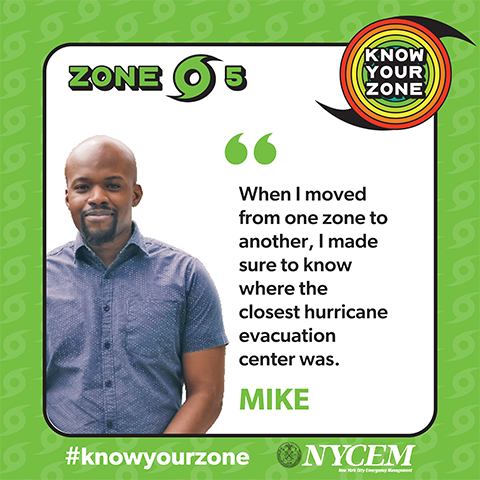
Make a Plan That Meets Your Needs
Our Hurricane Guide has information to help you prepare for a coastal storm or hurricane. Access the guide at www.nyc.gov/readyny.
- If you have a disability, access or functional need, make a plan that addresses how your needs may affect your ability to evacuate, shelter in place, or communicate with emergency workers. Get help from family, friends, or service providers if you will need assistance. If you can’t to evacuate on your own, contact 311 for assistance.
- If you depend on power for life-sustaining equipment, plan to evacuate. You may lose power following a hurricane. Ask your utility company if your medical equipment qualifies you to be listed as a life-sustaining equipment customer.
- If you or anyone in your home depends on electrically-powered life-sustaining medical equipment (such as a ventilator or cardiac device), receives dialysis or has limited mobility, there are specific steps you should take to prepare for a coastal storm.
- Allow additional travel time and consider your transportation, dietary, and medical needs (oxygen, extra batteries/chargers, eyeglasses, prescriptions, etc.)
- Bring all medications with you and have contact information for your health providers written down. Make a photocopy of your emergency contacts and health information. Always keep it in your wallet or purse.
- Learn more from the NYC Department of Health and Mental Hygiene about how to prepare for coastal storms if you have a disability or access or functional need.
What if I am ordered to evacuate?
People with disabilities or other access or functional needs, who have no other options to evacuate safely, can request transportation assistance if the City has issued an evacuation order because of a coastal storm or hurricane.
Depending on your need, you will either be taken to:
- An accessible evacuation center in an accessible vehicle, OR
- A hospital outside of the evacuation zone via ambulance.
You may not be able to request transportation to a specific address.
Specific instructions about which areas of the City should be evacuated will be communicated through various channels. If you live or are staying in an evacuation zone and your zone is ordered to evacuate, leave as soon as you can.
Use public transportation to evacuate if possible. When considering your transportation route, be aware that public transportation, including MTA's Access-A-Ride, may shut down hours before the storm arrives.
Use the Ready New York guide My Pet’s Emergency Plan to make a plan for your pet or service animal.
If you cannot shelter your pet at a kennel or with friends or relatives outside the evacuation area, pets are allowed at all City evacuation centers. Please bring supplies to care for your pet or service animal, including food, leashes, a carrier, and medication.
Learn more about emergency preparedness for pets on our Get Prepared page.
Residents of high-rise apartment buildings may face special risks from hurricanes even if they live outside evacuation zone boundaries.
- If you live in a high-rise building located in an evacuation zone:
- heed all storm warnings and evacuation orders.
- If you live in a high-rise building outside of an evacuation zone (especially on the 10th floor or above):
- Stay away from windows in case they break or shatter.
- You should move to a lower floor. Be aware of your building's evacuation plan.
- Read OSHA's tips for Evacuating High-Rise Buildings (in PDF).
- If you live in a basement:
- Sign up for Notify NYC’s Basement Alert Group to get special notifications in advance of flooding.
You may face additional risks from hurricanes even if you live outside evacuation zone boundaries. Many areas of the city can experience rainfall flooding. If you live in a basement apartment, be prepared to take shelter above ground, and move valuable items from basements to upper floors.
- Sign up for Notify NYC’s Basement Alert Group to get special notifications in advance of flooding.
If you cannot stay with friends and family outside an evacuation zone, the City will open evacuation centers throughout the five boroughs.
All evacuees will be accepted, and evacuees will never be asked about their immigration status at any New York City evacuation center or shelter.
Evacuation centers include accessible facilities and accommodations for people with disabilities and access and functional needs.* Pets and service animals are allowed at City shelters. Please bring supplies to care for your pet or service animal, including food, leashes, a carrier, and medication.
To find out the location of your nearest evacuation center, use NYC Emergency Management's Hurricane Evacuation Zone Finder.
If you are going to an evacuation center, pack lightly, and bring:
- Your Go Bag
- A change of clothes
- Sleeping bag or bedding
- At least a week's supply of any medication (if possible), medical supplies, or medical equipment you use regularly
- Toiletries
- Entertainment for children
For more information about staying at a City evacuation center, watch our video on the topic.
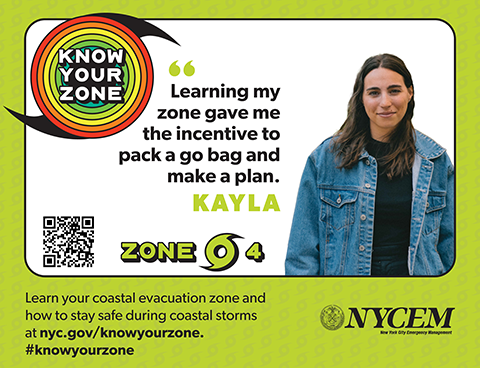
- Be prepared to lose power. Visit our Utility Disruptions page to make your plan in case you lose power.
- If you have concerns about how a loss of power, basic services, and public transportation may affect you, consider evacuating.
- Stay at home. If you do not need to evacuate, shelter in place and make use of your emergency supply kit. Stay away from windows in case they break or shatter and stay indoors to avoid hurricane hazards.
- Stay informed and connected by signing up for Notify NYC, the City's official emergency notification system. Listen to local weather forecasts and announcements from officials. NYC Emergency Management will send emergency alerts and updates to New Yorkers through various channels.
- Listen to authorities for information and special instructions.
- If your home was damaged in the storm, call 311 (212-639-9675 for Video Relay Service, or TTY: 212-504-4115) or use the following 311 form to report the damage and file a service request. Filing a service request is the only way to receive service from the City.
- It may take longer than usual to restore power and water if they are out. Do not use generators indoors.Take steps to prevent carbon monoxide poisoning if you use a generator.
- Be careful during clean-up. Our flooding page has helpful information on how to carefully clean up after a storm or flood. Electrical equipment can be dangerous and water can contain dangerous debris.
- Save phone calls for emergencies. Phone systems are often down or busy after a disaster. Use text messages or social media to communicate with family and friends.
- Document any property damage with photographs. Contact your insurance company for assistance.
The City works closely with the National Weather Service and National Hurricane Center to monitor severe weather threats that could affect the five boroughs. The City uses several forms of outreach to alert the public in an emergency, including Notify NYC, the City of New York's official emergency communications program.
The City maintains the Coastal Storm Plan, which describes a citywide response to a large-scale coastal storm event, particularly a hurricane. The Coastal Storm Plan includes scalable, standalone plans that describe the various operational strategies needed to respond to the impacts of a coastal storm. These standalone plans outline such operations as Interim Flood Protection Measures (IFPM), evacuation (including healthcare facility evacuation), sheltering, logistics management, donations and volunteer management, commodity distribution, debris management, and public information.
- Nor'easter: an intense storm that can cause heavy rain and snow, strong winds, and coastal flooding. Nor'easters have cold, low barometric cores. Nor'easters may occur at any time of the year but are most common during fall and winter months.
- Tropical Cyclone: an organized, rotating, low-pressure weather system of clouds and thunderstorms that develops in the tropics.
- Tropical Depression: a tropical cyclone with sustained winds of 38 mph or less.
- Tropical Storm: a tropical cyclone with sustained winds of 39 mph to 73 mph.
- Tropical Storm Watch: issued when there is a threat of tropical storm conditions in 48 hours.
- Tropical Storm Warning: tropical storm expected within 36 hours.
- Hurricane: a tropical cyclone with sustained winds of 74 mph or greater. Hurricanes are classified into five categories (1 through 5) according to the hurricane's sustained wind speed. As the wind speed and intensity of a storm increases, the category number increases.
- Hurricane Season: for the Atlantic, the season begins June 1 and ends November 30. (Historically, the greatest potential for hurricanes in New York City occurs from August through October.)
- Hurricane Watch: an announcement that hurricane conditions are possible within a specified area. Watches are issued 48 hours before tropical-storm-force winds are predicted to occur.
- Hurricane Warning: an announcement that hurricane conditions are expected within a specified area. The warning is issued 36 hours before tropical-storm-force winds are predicted to occur.
- Storm Surge: a dome of ocean water that is pushed ashore by the oncoming hurricane’s winds. Learn more about storm surge and other types of flooding
- Storm Surge Watch: the possibility of life-threatening inundation from rising water moving inland from the shoreline somewhere within the specified area, generally within 48 hours, in association with an ongoing or potential tropical cyclones, a subtropical cyclone or a post-tropical cyclone.
- Storm Surge Warning: the danger of life-threatening inundation from rising water moving inland from the shoreline somewhere within the specified area, generally within 36 hours, in association with an ongoing or potential tropical cyclones, a subtropical cyclone or a post-tropical cyclone.





